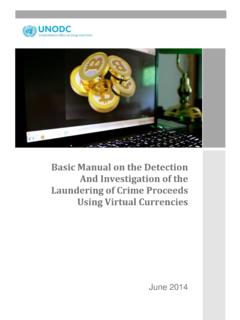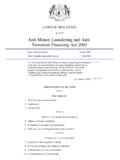Transcription of HSL 2002/022 - Investigation Into The Effective Laundering ...
1 Broad Lane, Sheffield, S3 7 HQTelephone:+44 (0)114 289 2000 Facsimile:+44 (0)114 289 2500 Crown copyright 2002 Investigation into The EffectiveLaundering Of Towels and Coveralls UsedFor Asbestos Measurement GroupG RevellProject Leader:SummaryObjectives The aims of this project were the contamination of towels and coveralls used in asbestos removal the effectiveness of the Laundering process when decontaminating thesetowels and coveralls. the laundries used to launder asbestos contaminated towels, particularly withregards to the safe handling of asbestos contaminated materials. Main telephone survey and follow up Investigation showed that very few commerciallaundries will launder asbestos contaminated towels / clothing. This has resulted in moreemployers making their own Laundering arrangements. Safety standards range from noprecautions (assumption is that towels are not contaminated) to the operation ofpurpose built laundries to the same standards as an asbestos removal contamination was found on towels used by asbestos workers.
2 This suggeststhat the towels became contaminated through the drying process and/or general misuseand that Effective decontamination procedures were not being followed. Amositeasbestos fibre densities of up to 154 f mm-2 were found on towels, intercepted (withagreement of the laundry) before Laundering , when sampled using micro vacuumingtechniques. However, mechanical agitation in a rotating drum dustiness tester producedairborne fibre concentrations of less than f ml-1. These fibre levels were calculatednot to be significant when workplace conditions were taken into account. asbestos was found on towels after Laundering . Although there was someevidence to indicate that asbestos fibre densities on heavily contaminated towels werereduced, the fibre levels on lightly contaminated towels appeared to be little changed bylaundering. Airborne fibre levels inside the rotating drum dustiness tester were generallyvery low (< f ml) but two towels, whose pre- Laundering contamination levels wereunknown, produced higher airborne fibre levels, f ml-1 and f ml-1 but thesame comments regarding workplace conditions apply as in was Effective in removing asbestos from coveralls.
3 Little or no evidence ofasbestos was found after asbestos contaminated coveralls were standards of cleanliness and the precautions taken with regards to safety (asbestos)at the two laundries visited were found to be very high. Both laundries were purposebuilt for dealing with asbestos contaminated laundry. They operated under negativepressure with the extracted air being HEPA filtered and appropriate precautions weretaken when handling towels and clothing prior to Laundering . These items wereregarded as being contaminated with asbestos. test simulating the handling of freshly laundered towels in a laundry showed that lowlevels of airborne fibres could be released when handling freshly laundered towels (< f ml-1 from forty towels over an eighteen minute period). Again, these fibre levelswere calculated not to be significant when workplace conditions were taken Recommendations1.
4 Employers should ensure that asbestos workers decontaminate themselves thoroughlyand properly, by taking sufficient time, care and attention, so that the decontaminationprocess is On returning via the dirty end of the hygiene unit all workers should shower thoroughlyand start the drying process in the shower section before returning to the clean end ofthe hygiene unit. Any towel taken into the shower section should be treated ascontaminated and be either disposed of as asbestos waste, or bagged up for washing ata laundry which has the facilities and expertise to launder asbestos contaminated Coveralls used during asbestos removal or renovation work should be treated ascontaminated with asbestos and removed in the dirty end of the hygiene unit. Thesecontaminated coveralls must either be disposed of as asbestos waste or bagged up forwashing at a laundry which has the facilities and expertise to launder asbestoscontaminated Contaminated towels should be bagged and laundered separately to Laundries dealing with asbestos contaminated items should assess the potential risksarising from this work (both pre and post Laundering ) and take the necessaryprecautions to prevent or minimise their employees exposure to asbestos.
5 Theseprecautions should include good mechanical air extraction (negative pressure); limitedaccess: a clearly defined lockable room(s) to which only designated staff are allowedaccess); regular air monitoring; and high hygiene standards).ContentsPage 2310. CONCLUSIONS AND RECOMMENDATIONS: ..Page Coveralls:..Page Handling of Towels in Towels:..Page Fibre Releases with Time:..Page What the values mean:..Page Fibre Counting Techniques:..Page 199. 178. HANDLING OF LAUNDERED Results From Coveralls Contaminated at HSL After Laundering :..Page Coveralls Contaminated With Asbestos at HSL: ..Page Rotating drum sampling: Laundered coveralls; Laundry Rotating drum sampling: Laundered coveralls; Laundry Rotating Drum Sampling: Laundered Micro Vacuum Sampling Laundered Coveralls:..Page 147. COVERALLS:..Page Rotating Drum Sampling: Contaminated Towels: Laundry Rotating Drum Sampling: Contaminated Towels: Laundry Rotating Drum Sampling: New Towel Laundered at Laundry Rotating Drum Sampling.
6 Page Micro Vacuum sampling: Contaminated Towels Laundered at Laundry Micro Vacuum sampling: Contaminated Towels Laundered at Laundry APage Micro Vacuum Sampling: HSL Contaminated Towel Laundered at Micro Vacuum Sampling:..Page Laundered Rotating Drum : Ex Hygiene Unit Contaminated Towels Intercepted onTheir Way to Laundry Rotating Drum: New Unused HSL Rotating Drum Sampling of Unlaundered 9 Micro Vacuum Sampling: Ex Hygiene Unit Towels Intercepted on TheirWay to Laundry 9 Micro Vacuum Sampling: Artificially Contaminated 8 Micro Vacuum Sampling: New Unused HSL 8 Micro Vacuum Sampling: Unlaundered 8 6. RESULTS: 8 Materials Sampled:..Page 7 Analysis for asbestos:..Page 6 Fibre Sampling:..Page 6 5. LABORATORY 5 Laundry B:..Page 4 Laundry A:..Page 3 4. VISITS TO 3 3. TELEPHONE 2 2.
7 LITERATURE 1 1. 2613. FIGURES:..Page 2512. 2411. FURTHER WORK .. Health and Safety at Work etc. Act [1974] requires an employer to provide a safe with asbestos is covered by its own set of regulations - the Control of Asbestos at WorkRegulations (CAWR) 1987 and currently supported by two approved codes of practice (ACoP).These require that when asbestos containing materials are removed or disturbed precautions have tobe taken to prevent or minimise exposure to airborne asbestos fibre releases. In effect this meansthat to minimise the risk of exposure to airborne asbestos, much work involving the disturbance ofasbestos requires the use of dust suppression removal techniques and the use of an enclosure undernegative pressure, the workers are required to use respiratory protection and protective clothing(either reusable or disposable coveralls), and for the workers to thoroughly decontaminate, includingshowering, on exiting the negative pressure enclosure.
8 These requirements also apply to any otherpersons (for example HSE inspectors) going into the prescribed work area. Showering is carried out in the central compartment of a three stage decontamination or hygiene end of the unit is classified as the 'dirty end' and here the worker leaves any contaminatedclothing. This contaminated clothing must be bagged and either disposed of as asbestoscontaminated waste or cleaned at a laundry that takes special precautions when handling asbestoscontaminated worker then showers and decontaminates his respirator in the shower unit before donning hisnormal work / street clothes in the 'clean end' of the hygiene unit. In some cases the towel is takeninto the shower compartment and in others the workers dry themselves in the 'clean end'. In theory,having showered, the worker should be free from asbestos contamination and the towels used to drythe workers, should not become contaminated.
9 In practice this has been found not to be the case, astowels may also be used to dry 'decontaminated' respiratory equipment and for a variety of otherfunctions, becoming contaminated in the process. Current HSE advice to removal contractors is that towels taken into the shower unit should betreated as contaminated and not returned to the 'clean end' of the hygiene unit. If the worker transitsto the 'clean end' and dries himself in there, the towel can then be considered to be uncontaminated(by asbestos). HSE commissioned this study into the state of towels used in asbestos removal hygiene units todetermine: whether towels used in hygiene units (for use with asbestos) are contaminated whether towels and coveralls are effectively decontaminated by the current and Fibres Section HSL approached the study by:Page 1wA literature search to investigate what previous work had been carried out in this telephone survey to determine how asbestos removal companies handle Laundering of towelsand experiments to examine whether towels become contaminated with asbestos bothbefore and after Laundering .
10 Similar experiments were to be carried out on SEARCHA literature search indicated very little or no work had been carried out in this area. A paper byGrosse [1998] showed that about ten percent of the asbestos (chrysotile) fibres from low levelcontaminated textiles remained after Laundering . It was however, noted that the continuous fibrillationof the asbestos fibres during Laundering reduced the length of many of these fibres so that they werebelow the lengths considered hazardous to health. An unpublished reference in internal HSE filesreferred to work which examined methods of detecting asbestos fibres on textiles. This reportconcluded that none of the asbestos identification methods employed enabled quantification ofasbestos contamination to be carried out. The report concluded that from qualitative examinationslaundering of contaminated clothing was Effective and that cross contamination was not a problem.
















